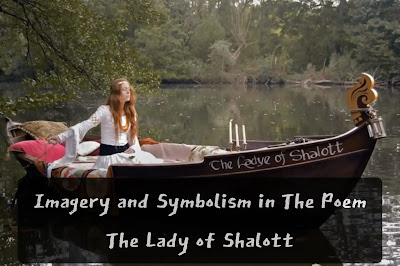Also Read
The Lady of Shalott is a symbolic imagery tale of a lady condemned by a mysterious curse to weave ceaselessly a magic tapestry. The poem itself has something of the effect of a tapestry, notably in the description of the passers-by in Part II, but it is far from being a piece of sentimental medievalising. Part I shows us the island castle of Shalott inhabited by the mysterious lady, and the road to Camelot, an image of the external world of action. In Part II we move to the lady herself, weaving compulsively under the strange curse, seeing external reality only thorough the mirror she uses for her weaving, and seeing it as a pageant in which she has no part. In Part III which takes place in harvest time, the magnificent Sir Lancelot, lover of Queen Guinevere, appears, riding to Camelot, and singing. As he goes, the lady leaves her tapestry and looks down to Camelot, and the curse is fulfilled. In Part IV (autumn), the dying lady floats down the river to Camelot singing her last song.
The stanzas continually contrast the active and external Camelot with the contemplative and withdrawn Shalott, except in Part III, where 'Lancelot' replaces 'Camelot' in stanza nine, and 'Shalott' in twelve. The four parts alternate between the external world and the world of the lady. There is also a division between the contemplative present tenses of Parts I and II and the active past tenses of Parts III and IV, prefigured by the first preterites in the poem in the last stanza of II: 'want', 'came,' 'said'.
This poem shows clearly the influence of Keats, in its colour, its nature-pictures, its use of contrast and its hyphen-words. Like Keats, Tennyson had a keen appreciation of natural beauty and he used his eyes, and the result is the unerring description which comes from a poet's command of language joined with first-hand observation. In Part I, we notice the exact description at the beginning of stanza 2, and such a choice of adjectives as "bearded barley". The pictures are given at length, elaborated with detail, colour and richness.
The poem combines two different aspects of Keats, the weird, magical suggestion of La Belle Dame sans Merci and the definiteness and colour of a poem like The Eve of St. Agnes. The lady is a fairy lady: the land is a romantic, visionary land: the exact nature of the spell is undefined. The curse seems more to be dreaded because it is a Mysterious curse which cannot be met. The haunting refrain adds to the magic. Yet the landscape is given in some detail, and the colouring of Part III is rich and glittering.
The contrast between the colour of Part III and what immediately precedes and follows: the warmness of the last stanza of Part II and the brilliant, rich colouring of Part III, and the dazzling sunlight of Part III and the heavy sky and rain of the first stanza of Part IV are striking. The weather harmonizes with each scene, helping to give the appropriate atmosphere (sympathetic background).
The Lady of Shalott is not an allegory though, as in Mariana the images sometimes have the power of symbols, says Steane. "The mirror, for instance, suggests much beyond its role as an item in a fairy story. For as the Lady weaves 'the mirror's magic sights' in her tapestry she is herself partly taking the role of the artist, and her existence in the island castle has something in common with the artist's apartness. Moreover, as she sees reality only through her mirror so the artist may tend to experience vicariously, drawing his knowledge not from direct contact but from other works of art. He has his own special nature, like the Lady; partly an affliction to him, this sense of difference, partly a blessing and possibly the very condition of his being an artist at all. For life in the ordinary day-to-day world he may be all unfit, as was the Lady, and, for him as for her, only disaster may follow the attempt to break bounds. This is not 'the message' of The Lady of Shalott, but it is, I think, a part of the ground out of which the poem grew."
